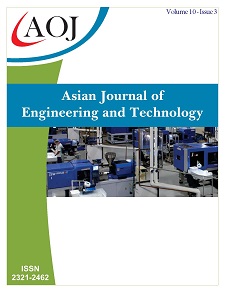Investigating Shoreline Migration due to Sand Mining in Some Communities of Yenagoa Local Government Area using GIS and Remote Sensing
DOI:
https://doi.org/10.24203/ajet.v10i3.7011Keywords:
GIS, Remote Sensing, Shoreline, YenagoaAbstract
This study investigates the impact of sand mining activities on some host communities within Yenagoa. The mining activities are considered to include the whole chain, from the dredging (mechanical or manual) to the end user (reclamation, filling, or construction). Impacts are assessed under categories ranging from environmental to infrastructural and ground damage. The methods of study include physical onsite observations and quick field assessments of soil type in areas directly connected with the river sand mining activities, and use of GIS and remote sensing techniques. Results show a direct link between the sand mining activities and damages to infrastructure, the natural environment, and shoreline migration. There is a steady increase in bare-land (i.e., land cover removal) and river expansion with increasing mining sites and dumpsites from 1990 to 2021.
References
British Standards Institute (BSI) 2015 BS5930 Code of Practice for Site Investigations (London: British Standard). P. 134
Byrnes M. R., Hammer R. M., Thibauta T. D & Snyder D. B. (2004). Potential effects of sand mining on physical processes and biological communities offshore, New Jersey, USA. J. Coastal Res., 20(1): 25-43.
Ezekiel, E. (2010). Nigeria needs N45 trillion to tackle housing deficit-FMBN. In Nigerian Business Forum. 18(1): 27-44.
Feola, A., Lisi, I., Salmeri, A., Venti, F., Pedroncini, A., Gabellini, M., & Romano, E. (2016). Platform of integrated tools to support environmental studies and management of dredging activities. Journal of Environmental Management, 166, 357-373.
Isah, R. (2011). Nigeria: Making housing fund contribution national agenda. [Online] Available at: http://allafrica.com/stories/201106240782.html (June 30, 2011).
Lusiagustin, V., & Kusratmoko, E. (2017). Impact of sand mining activities on the environmental condition of the Komering river, South Sumatera. In AIP Conference Proceedings. 18(1): 30.
Mbaiwa, J. E. (2008). Tourism development, rural livelihoods, and conservation in the Okavango Delta, Botswana. Texas A&M University, p. 23-25.
Naveen, S. M. (2012). Environmental impact of soil and sand mining: A Review. Int. J. Sci. Environ. Technol, 1, 125-134
Omole, D., & Ajakaiye, O. (1998). Environmental Externalities and Sustainable Urban development: who bears environmental costs. Sustainable physical development in Nigeria, Ibadan: Nigerian Institute of Social and Economic Research, p. 115-132.
Lawal, P. O. (2011). Effects of sand/gravel mining in Minna Emirate area of Nigeria on stakeholders. Journal of Sustainable Development, 4(1), 193.
Tesi, J. A., Tesi, G. O., & Enete, C. I. (2018). Assessment of the socio-economic impacts of river sand mining along the Warri River, Delta State. FUW Trends in Science and Technology Journal, 3(1), 56-59.
Downloads
Published
Issue
Section
License
Copyright (c) 2022 Alfred Wilson Opukumo, Austin Oyinkuro Oki

This work is licensed under a Creative Commons Attribution-NonCommercial 4.0 International License.
- Papers must be submitted on the understanding that they have not been published elsewhere (except in the form of an abstract or as part of a published lecture, review, or thesis) and are not currently under consideration by another journal published by any other publisher.
- It is also the authors responsibility to ensure that the articles emanating from a particular source are submitted with the necessary approval.
- The authors warrant that the paper is original and that he/she is the author of the paper, except for material that is clearly identified as to its original source, with permission notices from the copyright owners where required.
- The authors ensure that all the references carefully and they are accurate in the text as well as in the list of references (and vice versa).
- Authors retain copyright and grant the journal right of first publication with the work simultaneously licensed under a Attribution-NonCommercial 4.0 International that allows others to share the work with an acknowledgement of the work's authorship and initial publication in this journal.
- Authors are able to enter into separate, additional contractual arrangements for the non-exclusive distribution of the journal's published version of the work (e.g., post it to an institutional repository or publish it in a book), with an acknowledgement of its initial publication in this journal.
- Authors are permitted and encouraged to post their work online (e.g., in institutional repositories or on their website) prior to and during the submission process, as it can lead to productive exchanges, as well as earlier and greater citation of published work (See The Effect of Open Access).
- The journal/publisher is not responsible for subsequent uses of the work. It is the author's responsibility to bring an infringement action if so desired by the author.


